Background
“Storage of textile artifacts is a well-laid scientific process where all environmental factors, like humidity, temperature, light, etc., need to be suitable for every artifact. Apart from the environmental conditions, storage architecture and design are other important factors that can affect the safety of the objects” (Bhagat and Sachdeva 2023, 143).
When a Woman Rises, curated by Dr. Kristin Otto in collaboration Dr. Christine Ebert, is now closed and it is time to properly store the objects. The exhibit involved the display of more than 20 Maya textiles that are made of cotton, synthetic, and in some cases wool fibers. Textile objects are among the most sensitive in museum collections (NPS 2019, K:1), and their proper storage warrants special consideration. In terms of storing the textiles of When a Woman Rises, we are concerned with preventative conservation rather than curative conservation (Sunita and Binita 2023, 91). Preventative conservation is an approach that seeks to minimize the agents of deterioration (NPS 2019, K:1). Here I discuss registration, environmental management, handling, and storage (Sunita and Binita 2023, 96) of the objects exhibited in When a Woman Rises.
Environment
Textile storage needs to consider environmental stability (Sunita and Binita 2023, 97). Ideally, textiles should be stored at temperatures between 65º to 75º F and relative humidity (RH) near 50% ± 5% (NPS 2019, K:10; Thomson [1978] 1990, 268, 268; Boersma 2014; Bacharach 2019, 4:22, 427; Bauer Kilgo 2020, 506).1 Unfortunately, based on present environmental monitoring data, it looks as though the University Museum textile storage room temperature fluctuates outside of ideal conditions for about 8 months out of the year while RH is below of ideal parameters for 11 months out of the year. Notably, the entire building’s temperature fluctuates seasonally with summer heat and all monitored storage spaces are regularly below ideal RH parameters. These facts are a function of the museum being located in the high desert and that the building was constructed in 1930 by J.C. McElroy to serve as a men’s dorm and in 1986 converted by architect Rick Kentzler into to a museum facility (Grumet 2012, 245). The textile room is located on the North side of the building which may mitigate some fluctuation but the room does share an exterior wall which may contribute to seasonal temperature fluctuation. Lastly, HVAC systems in the facility are limited.
Textile fibers are hygroscopic, they readily absorb moisture (NPS 2019, K:10). Cotton, the most common seed fiber, is nearly pure cellulose, and is relatively rigid (NPS 2019, K:4). Given the conditions of the storage facility, high moisture is not a concern but low RH will contribute to brittleness of the fibers.
Storage
Textiles are highly susceptible to damage from mishandling and negligence (Bhagat and Sachdeva 2023, 97). There is enough variability in materials and construction methods that one formula for textile storage is insufficient, one must evaluate the object and determine the best method of storage. However, regardless of material, textiles generally tend to break along folds. This makes it preferable to avoid folding textile objects where possible. If an object must be folded for storage, it is necessary to pad the folds with crumpled unbuffered, acid-free tissue paper (NPS 2019, K:14).
The three most common forms of textile storage are:
- flat
- rolled
- hung
Flat Storage of Textiles
Generally, flat storage is best for textiles. Flat storage disperses the weight of the object, provides it with more complete support, and subjects the object to the least amount of strain (NPS 2019, K:15; Bhagat and Sachdeva 2023, 149). Gravitational pull is spread throughout the object reducing strain on specific points. Flat stored textiles should be placed between sheets of acid-free paper. Textiles that have fragile surfaces, beads, heavy embroidery, or other attachments can be fan-folded and supported on a muslin-covered, archival board or cardboard tray (NPS 2019, K:14).
Rolled Storage of Textiles
Rolling is a good storage technique for textiles that are too large to store flat and do not have folds or creases that would be damaged by rolling (Bhagat and Sachdeva 2023, 150). Common examples include rugs, tablecloths, and tapestries (NPS 2019, K:16). It is important to note that if textiles are folded before rolling there is a high potential for breaks to occur along creases; thus, folded textiles should not be stored rolled (Bhagat and Sachdeva 2023, 97).
Hanging Storage of Textiles
Hanging storage is not appropriate for most textile artifacts because hanging creates gravitational pull at certain locations of the object, and this can cause undue wear in those areas (Bhagat and Sachdeva 2023, 151). However, hanging storage is space efficient, and might be the only option for objects that are very three dimensional which would not be suitable for rolling or are too large to store flat without folding (Bhagat and Sachdeva 2023, 151).
When using hanging storage for textiles, standardized hangars are not appropriate; instead, object specific hangars should be used (Bhagat and Sachdeva 2023, 151). At minimum, this would involve additional padding applied to the hangar arms, but may involve fabrication of appropriately designed hangars.
Garment Storage: Fitted or Unstructured
Fitted, constructed garments in good condition may be stored hung. This would include European style suits or dresses (NPS 2019, K:15). Before hanging, determine if the shoulder seams are strong and intact, the the fabric is free of weakness, that the waistline can support itself without straining the waist or shoulders. If the answer to any of these is “no” then store the object flat.
While many of the textiles from When a Woman Rises are garments, they are not fitted and constructed garments in the European tradition. Rather, they fall into what is often referred to as “unstructured” clothing. Examples of unstructured clothing include: kimonos, ponchos, Pueblo and Hopi kilts and dresses, as well as “many forms of ethnic dress that use the rectangular shape of fabric yardage in clothing construction” (NPS 2019, K:18). The garments from When a Woman Rises fit this description very closely.
Unstructured garments that use the rectangular shape of fabric yardage are better stored flat, or with minimal folding, in an archival box (NPS 2019, K:18). The goal with flat storage of unstructured garments is to use as few folds as possible, provide sufficient padding to prevent creasing, and provide adequate support to lift the garment from the box or drawer (see NPS 2019, K:18 for more information).
In refurbishing the textile storage at the Regional Museum of Oaxaca, Klein (1997) and others opted for flat storage. Though from a different region of Mexico, in terms of materials and construction methods, the textiles at the Regional Museum of Oaxaca resemble those exhibited in When a Woman Rises. Given these similarities, flat storage of the When a Woman Rises textiles is preferable. However, in light of the constraints of the University Museum’s textile storage facility and its current shelving flat storage of large objects is impractical without an inordinate amount of folding. There is currently no space for storing boxes large enough to accommodate the objects. Therefore, I am opting for a form of custom hanger that mimics how Klein (1997) displays textiles in this Getty Conservation Institute case study (Figure 1).
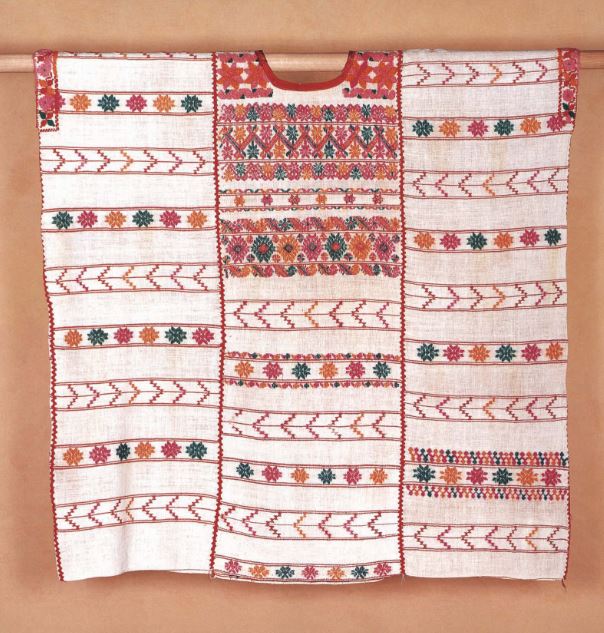
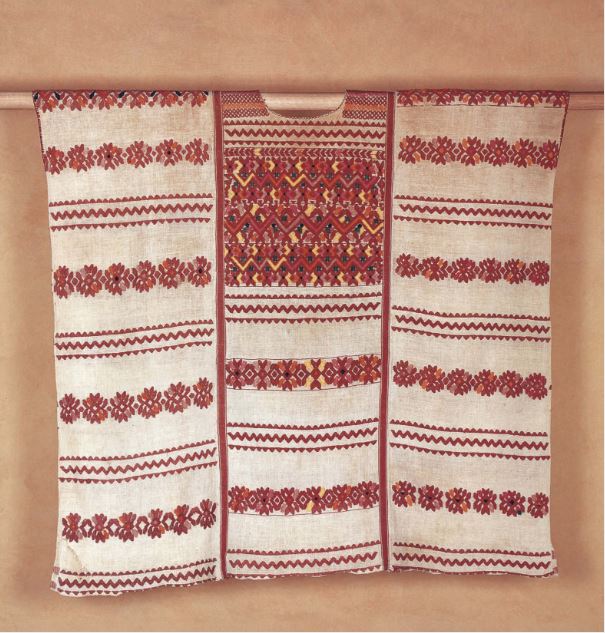
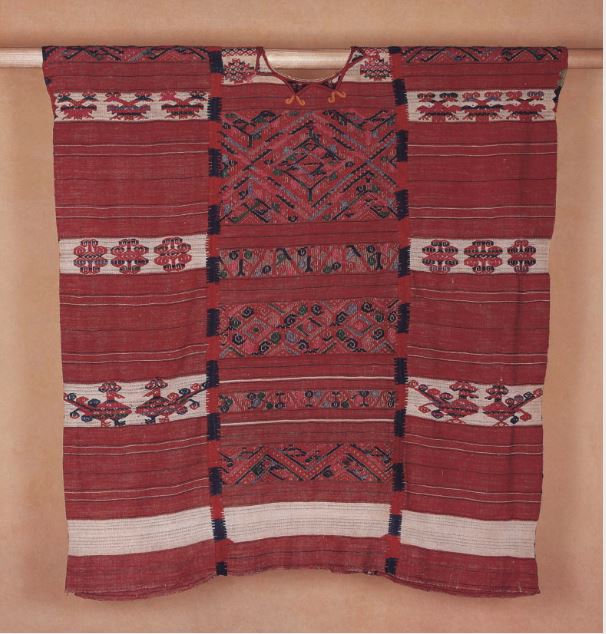
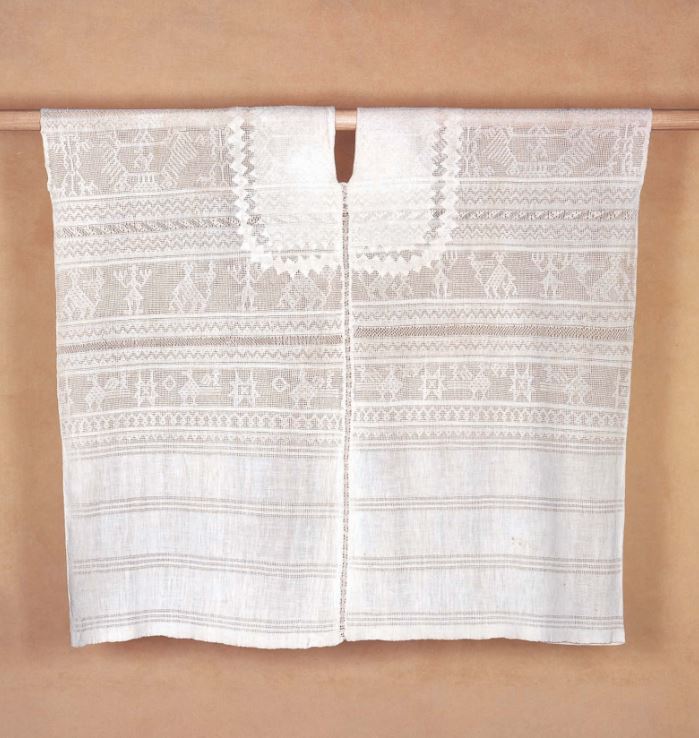
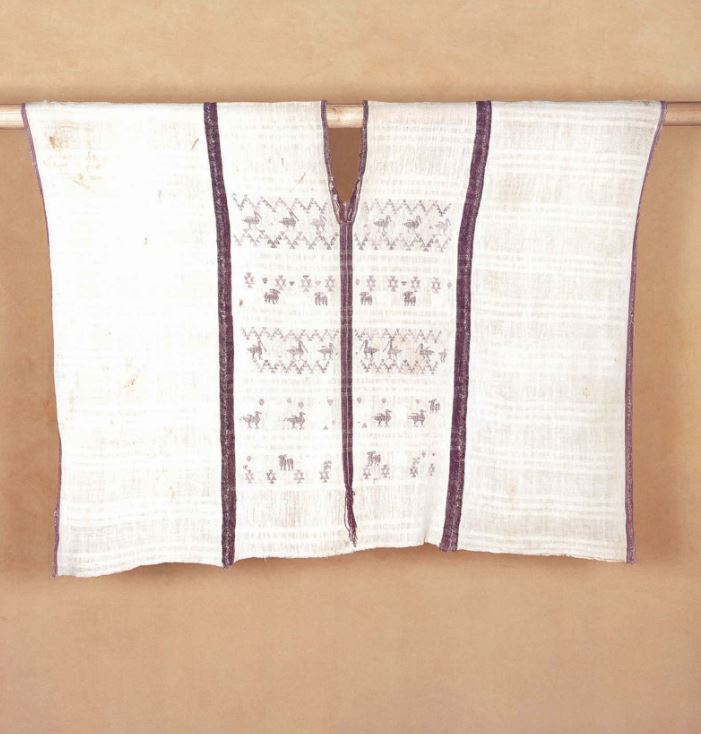
Hangers
Materials
- wood dowel (WHAT SIZE)
- screw in eye hooks for dowel end (WHAT SIZE)
- kite line 200-300 pound braided dacron
- Hooks
- S Hook (3¼ x 5¾) looks like it would do the job well
- S Carabiner Hook is very secure but likely won’t
- Ethafoam
- Acid free paper
The hanger will form an isosceles triangle with a known base, which is the length of the dowel. We can arbitrarily stipulate the height of the triangle to be anything we want, depending on how low from the rack we want the dowel to hang. The longer the sides, the lower the dowel will hang, and visa versa. Knowing the length of the dowel and our desired hanging height we can use the formula
When the base is 5 and the height is 5 then the side should be 5.59.
Method
- Cut a section of dowel appropriate for the length of the object
- Lightly sand the dowel ends to remove any splinters
- Screw eye hooks into the ends of the cut dowel, consider a pilot hole
- Double two separate sections of kite line for the appropriate length for the and tie one through each eye hole.
- Once tied, wrap dowel in Ethafoam and add a layer of acid free paper
- Carefully drape the textile on the dowel
- Use the S Hook to hang the object on the rack
References
Footnotes
See also “Rethinking the Museum Climate” as well as “The Plus/Minus Dilemma: The Way Forward in Environmental Guidelines” (transcript and video)↩︎
Using Observable JS I created a calculator to solve this equation, or use an existing calculator online.↩︎
Citation
@online{craig2023,
author = {Craig, Nathan},
title = {Maya {Textile} {Storage}},
date = {2023-06-29},
url = {https://ncraig.netlify.app/posts/2023-06-29-maya-textile-storage/index.html},
langid = {en}
}